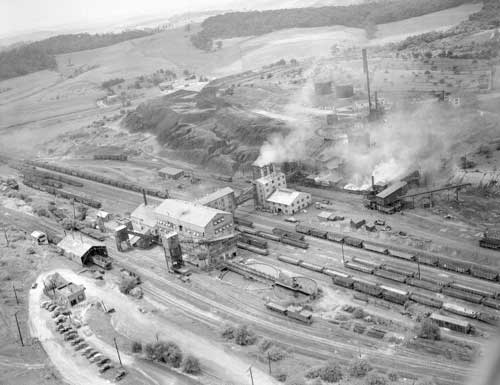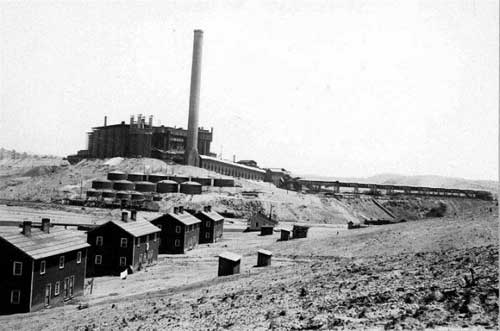 Recycling for Profit and Preservation by Bob Ciminel
 Photo courtesty the Historic Pittsburgh Image Collection at http://images.library.pitt.edu
In 1927, Pittsburgh Coal Company built the huge Champion No. 1 cleaning plant at aptly named Champion, PA. The Montour transported run-of-mine coal from the mines to the cleaning plant where it was washed and sorted before being reloaded for delivery to the Montour's five connecting railroads. Waste from the coal cleaning process was primarily slate and shale, locally known as "bony." The Montour set up a separate rail operation solely to haul the bony to a disposal site located a mile or two from the plant. In the Fifties, the plant installed a conveyer system to transport the bony to a new disposal site located across the highway from the plant, thus eliminating the need to haul the waste by train. Over the next 30 plus years, the new disposal site soon became a huge mountain of waste and an environmental time bomb. Piles of coal waste can spontaneously ignite and smolder for years, emitting smoke and noxious fumes. Runoff from the waste piles can pollute nearby streams with acidic water, adding to the pollution already caused by acid mine drainage. The abandoned piles of coal mining waste became the markers and monuments for a once thriving industry, but until recently served no other useful purpose. The Champion No. 1 waste pile along the former Montour Railroad right-of-way contains about 37.5 million tons of bony. The original railroad dump site west of the plant contains an additional 17 million tons of waste. Because of the high carbon content in the bony, the 55 million tons of coal waste can provide enough fuel to operate the new power plant for 25 years, generating 2.6 million megawatt-hours of electricity. At an average price of 7 cents per kilowatt-hour, recycling the waste can bring in about $2 billion dollars in revenues, which is not a bad return for burning "dirt."  Photo courtesy EPA
The Atlanta, Knoxville, and Northern Railroad, and its successors (Louisville and Nashville, Seaboard, and CSX), served Copperhill and the Ducktown mining district since 1896. The portion of the railroad between Copperhill and Etowah, Tennessee remained in service after the copper mines closed in 1987 thanks to the continued operation of a sulfuric acid plant, which was built in 1907 to process the sulfur dioxide gas emitted from the copper smelter. Although smelter operations ceased in 1987, the sulfuric acid plant began processing liquid sulfur, brought in by the railroad from the Gulf Coast. The acid plant closed in 2002 when the demand for sulfuric acid made it uneconomical to operate. This spelled the end for the railroad too, and CSX abandoned the rail line in April of that year. The tracks remained in place, and were purchased by a local organization in hopes of preserving the scenic route and, perhaps resurrecting it as a tourist line. Running short of money, the railroad was on the verge of a second abandonment when the Chinese decided they would extract the calcine waste and ship it to their steel mills. Later this year, the newly
incorporated Hiwassee River Railroad will begin running 75-car
unit trains to haul the calcine from Copperhill to Etowah, where
it will be picked up by CSX for delivery to Atlantic Coast ports
and loaded onto ships bound for China. This has to be the ultimate
recycling project. Not only are the Chinese paying for one of
our industrial waste products, they are also accepting the environmental
pollution that will occur when the calcine is turned into iron
in their steel mills. For the residents of Copperhill, it is
a win-win situation. He assumes informed readers will be able to tell the difference. ciminel@sitnews.us
|